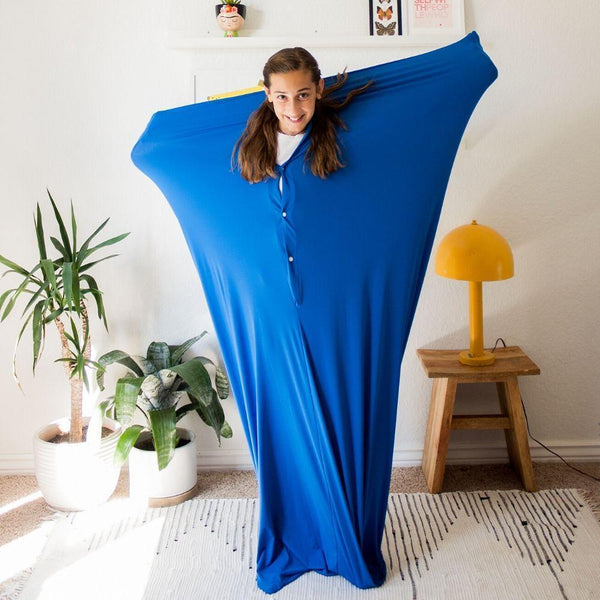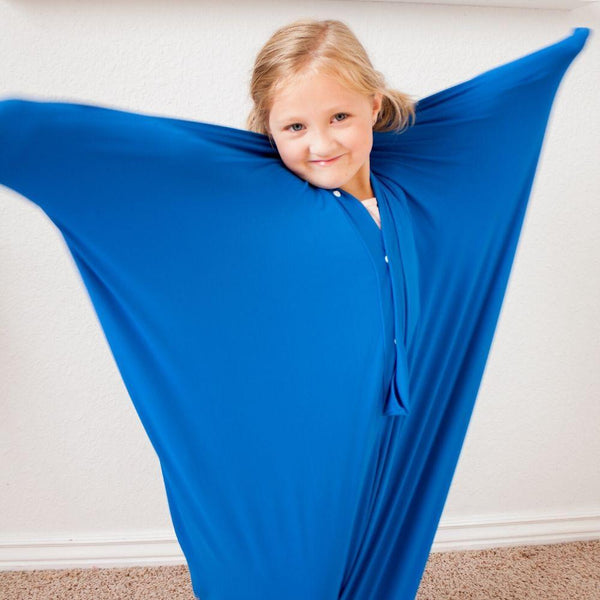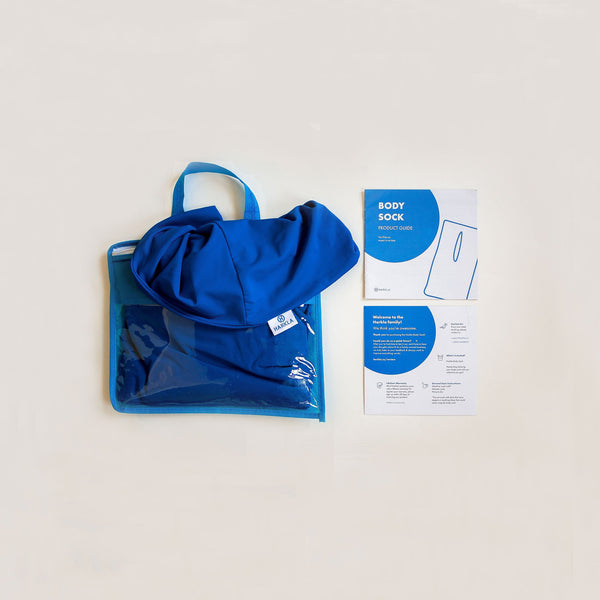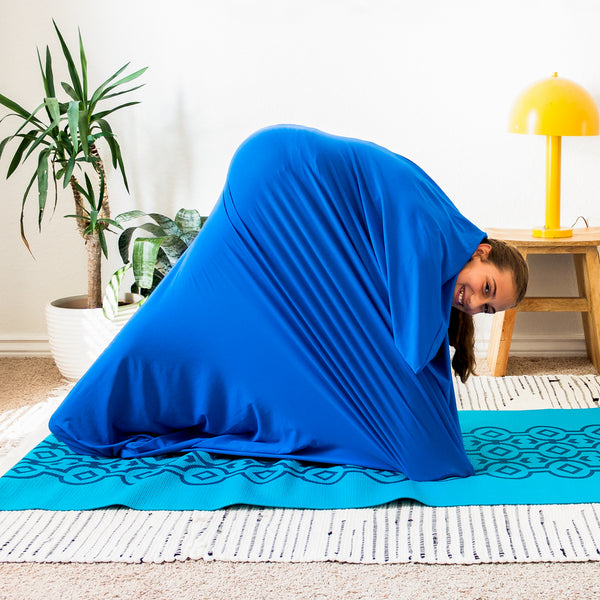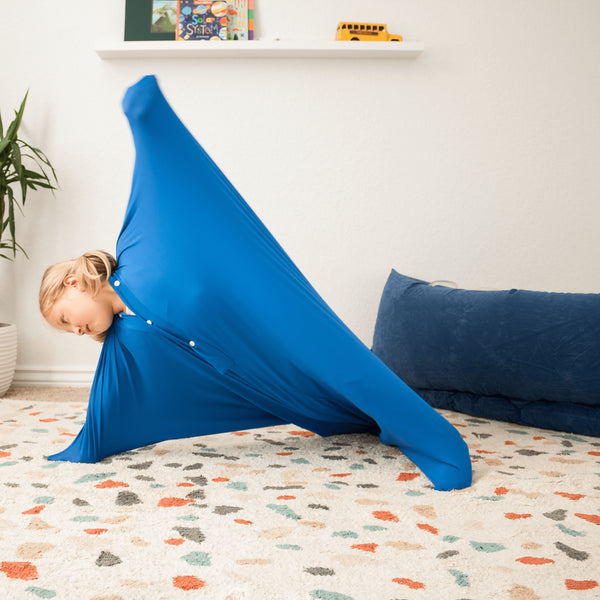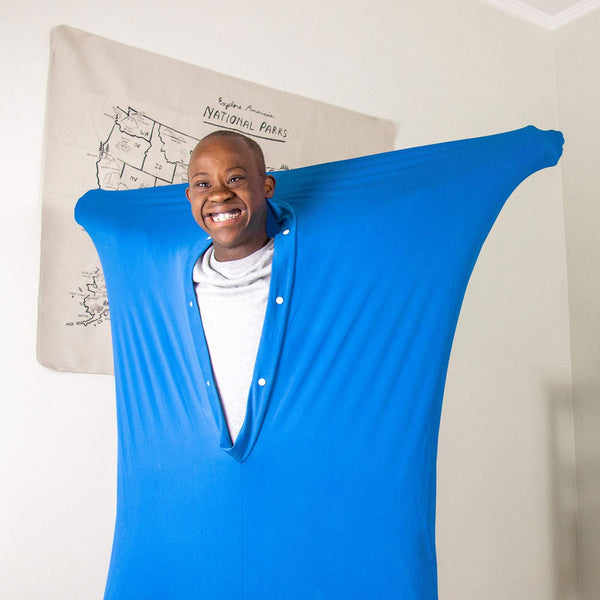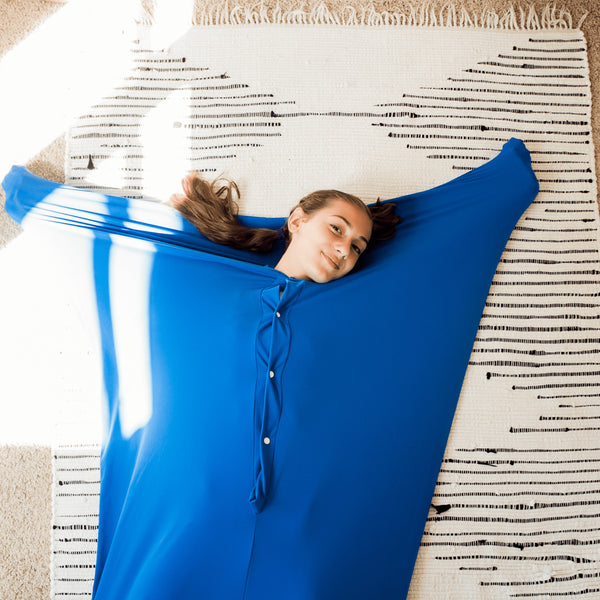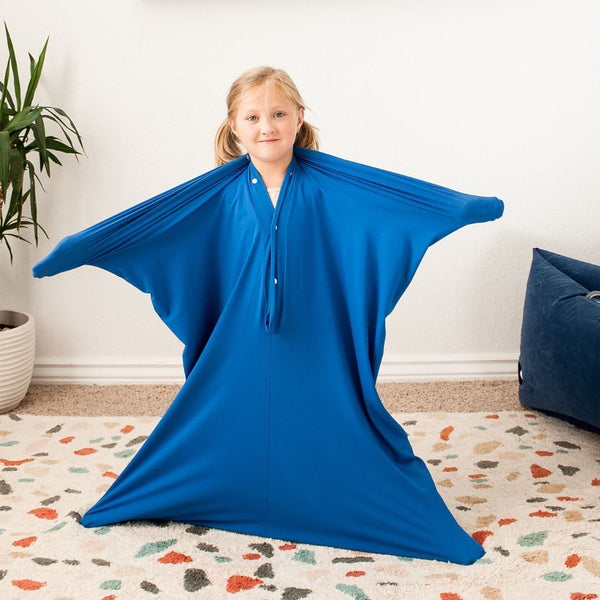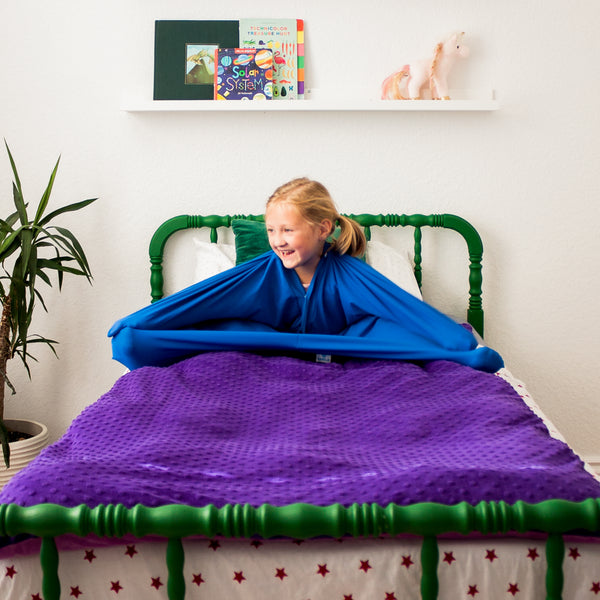MATERIALS:
80% Nylon | 20% Spandex
Plastic Snaps: Located at head opening
MEASUREMENTS:
Small: 27 inches wide x 40 inches long
Medium: 27 inches wide x 48 inches long
Large: 28 inches wide x 56 inches long
X-Large: 30 inches wide x 64 inches long
WHAT'S INCLUDED:
Harkla Body Sock
Handy Bag (to bring with you wherever you go!)
Product Activity Guide
STRETCH. PLAY. DEVELOP. UNWIND.
Do you wish your child had an easier time relaxing? The Harkla Body Sock is designed with autism and sensory issues in mind. Your child will love to play, stretch, or relax in our sensory sock! It also gives the tactile benefit for seekers because it is soft and stretchy to the touch. The body sock provides calming and organizing input all over the body at the same time.
.
HELP YOUR CHILD DEVELOP SPATIAL AWARENESS
Not only do sensory socks help to soothe and calm, but a body sock can also encourage your child to explore their movements by pressing and stretching the material. The Harkla Body Sock gives immediate feedback to the tactile and proprioceptive systems when it is worn, both in one static position or used for dynamic movement based tasks. Start developing right away with the activity guide created by occupational therapists provided in each package.
.
STAND UP TO THE TOUGHEST OF PLAYTIMES
Designed with double-stitched seams & strong snaps instead of velcro.
The Harkla Body Sock Fits The Very Best When:
THE USER'S HEIGHT IS EQUAL TO OR SLIGHTLY TALLER THAN (NO MORE THAN 5") THE BODY SOCK LENGTH
We recommend that you measure your child to ensure purchasing the correct size. Measuring the height of the user is crucial to ensure purchasing the correct size.
* The Body Sock fits the very best when the user's height is equal to or slightly taller than (no more than 5") the Body Sock length. (In-between sizes? We recommend the size down to ensure compression is properly felt during use)
We think children with special needs should have every opportunity to live happy and healthy lives. That's why Harkla is dedicated to providing families with the best products and resources for raising a special needs child. Read more of our story here.
Are there recommended activities for a body sock?
Yes! In fact, we asked occupational therapists to put together an activity guide that comes included in your order. Click here to get an electronic copy and discover all options for a body sock.
What happens if the body sock gets damaged from use?
Things happen! That’s why all of our products come with a lifetime guarantee including the body sock. Unless you are 100% satisfied, we aren’t satisfied either. We're a company that truly cares about you and will answer any questions or concerns you have.
Once you get your product, simply visit harkla.co/warranty to register your warranty.
Where Do We Ship This Product?
From the Harkla Website, we only ship this product to the United States.
However, if you are looking for us in another country, we have options for purchasing!
Canada: Shop our store on Amazon Canada
Australia: Shop for us with our Australian Partner Starfish
If you're looking for another country, please check out our partner page to see if our products are available in your country through another retailer!
If you’d like to be informed of when we will be shipping to your country, please contact our customer service: support@harkla.co
What is the sensory body sock?
The sensory body sock from Harkla is a giant “sock” for your body! Made out of 80% nylon/20% spandex, it provides just enough stretch to move while also providing compression feedback to engage the muscles and the proprioceptive system.
Because it is soft, it also provides a pleasant tactile experience. With snaps located at the opening, it is easy to open and close without scratchy velcro—the perfect item to use for play, to help calm, and to relax in.
Who can benefit from the sensory body sock?
The sensory body sock was created with sensory inputs in mind - meaning children (and adults!) who struggle with sensory processing are the main beneficiaries of the sensory body sock.
Let’s break it down a bit more.
If a child is struggling with vestibular processing, they seek out all types of movement that interfere with daily tasks. They are clumsy, uncoordinated, or get motion sickness. The sensory body sock can be a great item to use to provide controlled movement!
If a child is struggling with proprioceptive processing, they seek out heavy work (such as pushing, pulling, jumping), they use too much force with tasks such as writing or playing, or they struggle with understanding where their body is in space (may seem clumsy or get hurt often). The sensory body sock can be a great addition to their play items to provide proprioceptive feedback!
If a child is struggling with self-regulation and attention, they get frustrated easily, they cannot sit and attend to a task for an age-appropriate amount of time, or they are unable to solve problems that are age-appropriate. The sensory body sock can be a great tool!
If a child has a diagnosis or signs/symptoms of ADHD/ADD, Autism, Down Syndrome, Developmental Delay, cognitive/learning challenges, Apraxia, SPD, or speech/language delay, the sensory body sock is a great addition to their play and development.
Different Types of Sensory Inputs Provided by the Body Sock
The two main types of sensory input the body sock provides are proprioception and tactile. It also can provide opportunities for more vestibular input.
Proprioception
Proprioception is the awareness of the position and movement of the body. Sensory receptors are located on your skin, joints, and muscles. When we move, these sensory receptors send signals to our brain, telling it about the effort, force, and heaviness of the movement. Then our body is able to provide an appropriate response.
When we think about proprioceptive movement, we can also include heavy work - any movement that works the muscles, deep pressure - any input that provides pressure to our body, and vibration. Proprioceptive input is typically calming to the nervous system.
Individuals are usually not over-responsive to proprioception, meaning they don't have over-reactions to this type of sensory input. We do, however, see individuals who are under-responsive or sensory craving, meaning they want more heavy work, crashing, hugs, etc.
The sensory body sock provides proprioceptive input through the stretchy material that can be pulled on and pushed against.
Tactile
Tactile inputis received through our skin. It includes light touch, firm touch, and the discrimination of different textures, including dry to wet and messy. The tactile system is also responsible for the processing of pain and temperature. Tactile input can be alerting, calming, or over-stimulating, depending on the person.
The sensory body sock provides tactile input that can be calming due to the soft material. It gives immediate feedback to the tactile and proprioceptive systems when worn, both in one static position or used for dynamic movement-based tasks.
Vestibular
The vestibular system is located in the inner ear. This system is directly related to balance and vision - specifically eye movements. Because of the location in the inner ear, the vestibular system is activated with head movements. When the head moves, the eyes move, and the brain and body must respond - balance!
When we think about vestibular input, we can think about running, jumping, spinning, and swinging. These movements activate the vestibular system and will provide a response - some people can tolerate more movement than others, while some become easily nauseous with movement (motion sickness). Vestibular input is typically alerting to the nervous system.
The sensory body sock provides vestibular input because you can move in it! Depending on how you position your body, you can receive linear vestibular input - back and forth or side to side, or rotary vestibular input - spinning.
Some individuals become easily over-stimulated by vestibular input. This can cause adverse reactions such as nausea/vomiting or irritability (among others). Some individuals seek vestibular input - constantly on the move, seeking out opportunities to spin and jump.
Because the sensory body sock provides proprioceptive, tactile, and vestibular input, it can be used to achieve a sense of calm or to achieve a higher arousal level.
Another Added Benefit
Another area that the sensory body sock adds to is body awareness and spatial relations. When we complete an activity that provides proprioception and vestibular input, our ability to understand our body in space better and within our environment improves. This has the added benefit of improving safety, coordination, and motor planning!
Tips For Introducing The Sensory Body Sock to Your Child
If your child is unsure about the sensory body sock, try these tips to engage them:
- Model! Get in the body sock and show your child how to climb in and out. Let your child watch you have fun in the body sock. Allow your child to help you.
- Place favorite toys in the body sock and allow your child to pull their toys around.
- Use the body sock on a soft surface such as cushions to decrease falling on a hard surface.
- Allow your child to choose how to interact with the body sock. Allow them time to explore.
- Never force your child to get in the body sock unwillingly. It will take them longer in the long run if we push them!
- Include other preferred sensory input while introducing the sensory body sock, such as essential oils, a weighted vest, favorite music, etc.
- Avoid pressuring your child to get in the body sock as well. This includes positive pressure, i.e., “If you get in the body sock, you can have a piece of chocolate!” Leave it out, let them explore, walk away (if safe) and when they get in on their own, don’t make a big deal about it! Just talk to them calmly about how it feels, what they think, etc.
Tips for Incorporating the Sensory Body Sock into Your Child’s Day
Incorporating the sensory body sock into your child’s daily routine can help with self-regulation throughout the day as well as can add a playful element into the day.
Here are some tips for incorporating the body sock into your child’s routine:
- Add the body sock to the morning routine to help “wake up”.
- Use the body sock as a “brain break” in between school/homework.
- Offer the body sock after school, before getting started on homework, chores, or extracurricular activities to reset the nervous system.
- Use the body sock as part of a sensory diet to help with arousal level.
- Allow your child to use the body sock independently in order to de-stress or calm down when upset.
- Use a visual timer to include a start and stop. “First, we’re going to play in the body sock for 3 minutes. Then we’re going to do 30 seconds of bear crawling.”
Final Thoughts On Body Socks
The sensory body sock can be a great addition to your child’s bedroom, playroom, or living room. There are so many ways to utilize the body sock in order to help your child with self-regulation, sensory processing and integration, body awareness, and more!
If you'd like to learn more about the science behind our sensory body socks, or ways you can incorporate it into your child's life, here are some articles to check out:



